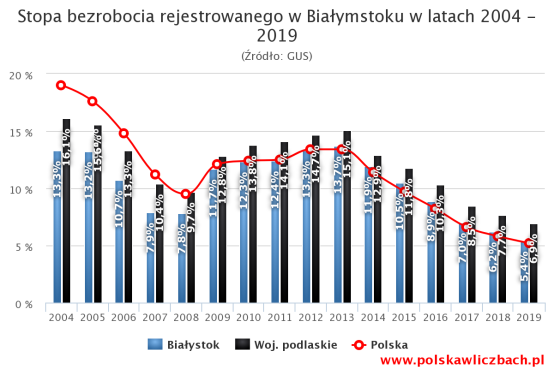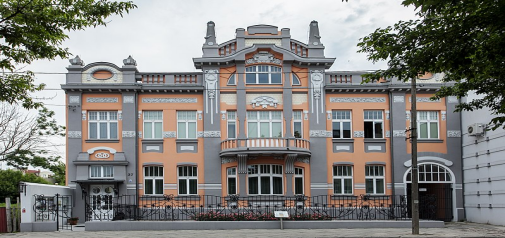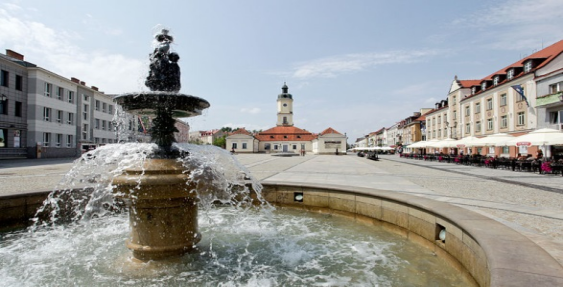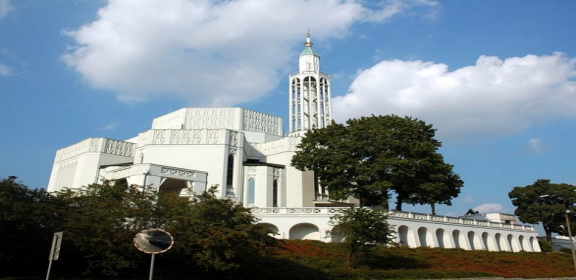Białystok- Podlaskie 作者: 来源: 发布时间:2021-05-19
Ⅰ. Population and Area
Population (31 December 2019)
• Urban 297,554 Increase (10th)
Area
• City 102.12 km2 (39.43 sq mi)
Website
www.bialystok.pl
Ⅱ.Natural Geography
Białystok is situated in the Białystok Uplands (Polish: Wysoczyzna Białostocka) of the Podlaskie Plain (Polish: Nizina Północnopodlaska), part of what is known collectively as the Green Lungs of Poland. It is the biggest Polish city close to Belarus and Lithuania. The Biała River, a left tributary of the Supraśl River, passes through the city. The landscape of the Białystok Upland is diverse, with high moraine hills and kame in excess of 200 m (660 ft) above sea level. Vast areas of outwash, a glacial plain formed of sediments deposited by meltwater at the terminus of a glacier, are covered by forests.
Forests are an important part of the city character, they currently occupy approximately 1,756 ha (4,340 acres) (17.2% of the administrative area of the city) which places it as the fifth most "wooded" city in Poland; behind Katowice (38%), Bydgoszcz (30%), Toruń (22.9%) and Gdańsk (17.6%).
Part of Knyszyn Forest is preserved within the city limits by two nature reserves—a total area of 105 ha (260 acres). The Zwierzyniecki Forest Nature Reserve (Polish: Rezerwat przyrody Las Zwierzyniecki), which is contained within the city limits, is a fragment, 33.48 ha (82.7 acres), of the riparian forest with a dominant assemblage of oak and hornbeam. The Antoniuk Nature Reserve (Polish: Rezerwat Przyrody Antoniuk) is a 70.07 ha (173.1 acres) park in the city that preserves the natural state of a forest fragment characteristic of the Białystok Upland, with a dominant mixed forest of hazel and spruce.
The 40 ha (99 acres) of forests lying in the vicinity of the Dojlidy Ponds are administered by the Central Sports and Recreation Center in Białystok (Polish: Miejski Ośrodek Sportu i Rekreacji w Białymstoku – MOSiR). The Dojlidy Ponds recreation area includes a public beach, walking trails, birdwatching and fishing.
Transport
The city is and has been for centuries, the main hub of transportation for the Podlaskie Voivodeship and the entire northeastern section of Poland. It is a major city on the European Union roadways (Via Baltica) and railways (Rail Baltica)[150] to the Baltic Republics and Finland. It is also a main gateway of trade with Belarus due to its proximity to the border and its current and longstanding relationship with Hrodna, Belarus.
A traffic management system has been operating in Białystok since 2015. At 120 intersections, traffic lights are coordinated in such a way that cars and buses covered the route as quickly as possible. Special cameras record traffic, travel time. Drivers receive this information on 19 boards set among others at the intersections on Wasilkowska Street, Antoniuk-Fabryczny Street and Kleeberga Street.
Railways
Passenger trains connect from Suwałki, Grodno and Lithuania to Warsaw and the rest of the European passenger network. Passenger services are provided by two rail service providers, PKP Intercity that provides intercity passengers trains (express, intercity, eurocity, hotel and TLK) and Przewozy Regionalne that operates only regional passenger trains financed by the voivodeship. Passenger trains are mostly run using electrical multiple units (on electrified lines) or rail buses.
Example picture of public bus service in the city
Solaris Urbino 18 W29 bus operated by BKM in Białystok
Buses
There is an extensive bus network that covers the entire city by three bus services, but no tram or subway exists. The three bus operators (KPKM, KPK and KZK) are owned by the city and each shares approximately a third of the lines and the bus fleet.
Roads and highways
The National Roads (Polish: Droga krajowa) running through Białystok:
DK 19: Rzeszów – Lublin – Bielsk Podlaski – Białystok – Kuźnica (Belarus–Polish border)
DK 65: Gołdap (Russia–Polish border)-Ełk-Białystok-Bobrowniki (Belarus-Polish border)
S8 / E67: Budziska (Polish–Lithuania border) – Białystok – Warsaw – Wrocław – Kudowa-Zdrój (Czech–Polish border)
DW 676: Białystok - Supraśl - Krynki
DW 678: Białystok - Wysokie Mazowieckie
DW 669: Narodowych Sił Zbrojnych Street
DW 675: Poleska Street and Tysiąclecia Państwa Polskiego Street
In Białystok there are also Poviat roads which connect the city with other towns in the area
Poviat Road 1431 B: Białystok (42 Pułku Piechoty Street) - Sowlany
Poviat Road 1432 B: Białystok (Ciołkowskiego and Baranowicka streets) - Zielona,
Poviat Road 1483 B: Białystok (Filipowicza) - Hryniewicze
Poviat Road 1484 B: Białystok (Mickiewicza Street) - Stanisławowo
Poviat Road 1485 B: Białystok (Plażowa Street) - Dojlidy Górne
Poviat Road 1493 B: Białystok (Wiosenna Street) - Olmonty
Poviat Road 1535 B: Białystok (Popiełuszki, Hetmańska and Wierzbowa Streets) - Choroszcz
Poviat road 1550 B: Białystok (Niewodnicka, Meksińska, Nowosielska and Elewatorska streets) - Klepacze - Niewodnica Kościelna,
Poviat road 1559 B: Białystok - Kleosin
Bicycle
The municipal bicycle renting system is called BiKeR and was opened in 2014. System initially based on 30 stations equipped with 300 bikes. By 2018, there were already over 130 km of bicycle paths in Bialystok. The city has four bicycle repair stations, in which one can fix his private bikes. The stations are located in places where the highest traffic of city bikes was observed.
Airports
A civil airport, Białystok-Krywlany Airport, lies within the city limits, but does not provide regularly scheduled service.[158] There were plans in 2011 to build a new regional airport, Białystok-Saniki Airport, that would have provided flights within Europe.
Ⅲ.Economy
The unemployment rate for February 2011 in Białystok was 13.2%. The 2009 average household had a monthly per capita income of 1018.77 zł and monthly per capita expenses of 823.56 zł
The labor market in a nutshell (Source: GUS, 31.12.2018) 296 people work per 1,000 inhabitants in Białystok. This is much more than the value for the Podlaskie Voivodeship and much more than the value for Poland. 55.6% of all employed persons are women, and 44.4% men. Registered unemployment in Białystok was 5.4% in 2019 ( 5.3% for women and 5.5% for men). This is much less than the registered unemployment rate for the Podlaskie Voivodeship and more than the registered unemployment rate for the whole of Poland. In 2018, the average monthly gross salary in Białystok was PLN 4,396.32 , which corresponds to90.90% of the average monthly gross salary in Poland. Among the economically active inhabitants of Białystok, 4,330 people go to work in other cities, and 11,402 working people come to work from outside the commune - so the balance of arrivals and departures to work is 7,072 . 3.2% of professionally active residents of Białystok work in the agricultural sector (agriculture, forestry, hunting and fishing), 20.4% in industry and construction, and 27.1% in the service sector (trade, vehicle repair, transport, accommodation and catering , information and communication) and 4.5% works in the financial sector (financial and insurance activities, real estate services).

Więcej: https://www.polskawliczbach.pl/Bialystok
The sum of budget spending amounted to Bialystok in 2018 year 2.18 billion , which gives 7.3 thousand zlotys per capita. This means an increase in expenses by 14.9% compared to 2017 . The largest part of Białystok's budget - 31.2% was allocated to Department 801 - Education . A large part of the budget expenditure was allocated to Division 600 - Transport and communications ( 27.1% ) and to Division 852 - Social assistance ( 5.2% ). Capital expenditure accounted for PLN 604.6 million , i.e. 27.7%total expenditure. Total revenue for the budget of Bialystok was in the 2018 year of 2.06 billion zlotys, which gives 6.9 thousand zlotys per capita. This means an increase in income by 15.3% compared to 2017 . The largest part of the income was generated by Department 756 - Income from legal persons, natural persons and other entities ( 31.1% ). A large part of the proceeds comes from Division 758 - Miscellaneous ( 20.4% ) and from Division 600 - Transport and communications ( 17.2% ). In the budget of Białystok, income from personal income tax amounted toPLN 1.4 thousand per capita ( 19.8% ), while the income from corporate income taxes was PLN 65.8 per capita ( 1.0% ). Other tax revenues, established and collected on the basis of separate acts, accounted for 9.5% .
Więcej: https://www.polskawliczbach.pl/Bialystok#finanse-publiczne
Białystok is a new space of technology, science and talent
The field of cooperation between science and business as well as the place for the development of academic and startup entrepreneurship is the Białystok Science and Technology Park (BPN-T). It is the first certified technopark in Eastern Poland. There is an efficient Technology Incubator for young, dynamically developing companies, especially in the following industries: IT, DTP, medical, 3D printing, etc. BPN-T Technology Center offers: specialized laboratories equipped with the latest equipment, training rooms and offices for rent. In addition, the Park includes Transferownia - a space for meetings for science and business, and a Centroom - a coworking office.
Białystok for business, investments and new jobs
The city is constantly investing in improving the communication system and increasing the availability of investment areas. The Białystok Subzone of the Suwałki Special Economic Zone (SSEZ) is an investment area with technical infrastructure and a new communication system. Investments in the Subzone and in the BPN-T area translate into favorable terms of use for each Investor, including tax reliefs and exemptions.
Białystok is one of the leaders when it comes to the number of investments implemented with EU support. Investment expenditures are a priority, Białystok comes second among voivodship cities in terms of the share of investment expenditures in relation to the total amount of expenditures. Road infrastructure, both of local and transit importance, gained the most in this area, which shows the first place among voivodeship cities in terms of the share of expenditure on public roads in total expenditure. The Rail Baltica railway route runs through Białystok, which is an element of the trans-European transport corridor connecting Warsaw, Kaunas, Riga, Tallinn and Helsinki. The Via Carpatia road route also runs through Białystok, partially overlapping the S-19 and S-8 roads, connecting the countries of Southern Europe with Scandinavia.
Ⅳ.Industrial Characteristics
The leading industries in the economy of the city of Białystok are, among others machinery, electromechanical, electrical, food and textile / linen industries. The dynamically developing industry and high technology services play an increasingly important role. This industry includes the production of specialized medical equipment, electronics, information technology and controlled automation.
According to the data as of December 31, 2014, 33 735 business entities and 3 193 commercial companies were registered in the REGON register in the city of Białystok. In the total number of commercial companies, 2,924 were companies with private domestic capital and 414 companies with foreign capital, including 244 with homogeneous foreign capital.
In Białystok, foreign capital is represented by, inter alia, the following companies: Russian Standard Corporation - CEDC International Sp. z o. o. Polmos Białystok branch, Standard Motor Products Inc - SMP Poland Sp. z o. o., ALTRAD - Altrad Poland SA, Nordstjernan - Rosti Polska Sp. z o. o., Nordstjernan - Rosti Bianor Sp. z o. o., NIBE AB - Nibe Biawar Sp. z o. o., Mecom Press AS - Media Regionalne Sp. z o. o., SABMiller Group - Production plant: Kompania Piwowarska SA Browar Białystok, ESSMeditec AB - BiaMediTek Sp. z o. o., NSG Group - Pilkington Automative Poland Sp. z o. o. "Metal" branch in Białysto
In the nineteenth century Białystok was an important center for light industry, which was the reason for the substantial growth of the city's population. The tradition continued with many garment factories established in the twentieth century, such as Fasty in the district of Bacieczki. However, after the fall of communism in 1989 many of these factories faced severe problems and subsequently closed down.
grain silos
Silos of Podlaskie Zakłady Zbożowe (Podlaskie Cereal Industrial Plants)
The bison grass vodka called "Żubrówka" is made in Białystok at the Polmos Factory
The leading industries in the city's economy are: food processing (production of meat products, fruit and vegetable products, the production of spirits, the production of frozen food, grain processing), electrical engineering (production tools and equipment for machine tools, production of electric heaters, manufacture and production mixers household appliances). There is also a developed machine industry (electronics, machinery and metal), plastic processing (production of household appliances), textiles (textiles and upholstery, manufacture of underwear, clothing accessories, footwear and backpacks), Wood (production plywood and furniture) building materials.
https://www.bialystok.pl/pl/dla_biznesu/aktualnosci/
Key Projects
1. Commencement of the preparation of the local spatial development plan for a part of the Sienkiewicza estate in Białystok in the area of Towarowa and Wąska streets
Business news - Rising Białystok - The Official Portal of the City https://www.bialystok.pl/pl/dla_biznesu/aktualnosci/
2. The city of Białystok is preparing for the next housing estate road investment. It concerns Jaśminowa Street. The tender has already been announced. Offers can be submitted until August 20.
It is a fragment of Jaśminowa Street from the intersection with Jana Karskiego Street to property No. 144/2. It is a 100-meter section with a dirt surface. The city intends to build a new road there, sidewalks and exits to the property and a cable lighting line. Lawns will also be created in this section.
- It is a street with single-family houses. The traffic there is not too big, but this investment will make it easier for residents to get to their homes and will definitely improve the aesthetics of the estate , says Deputy Mayor Przemysław Tuchliński.
The construction will be financed from the city budget. The contractor will have three months to complete the investment from the date of signing the contract. Currently, a tender has been announced to select a contractor for this investment. Tenders can be submitted until August 20 to the following address: Municipal Office in Białystok, Public Procurement Office, ul. Słonimska 1, 15-950 Białystok. Detailed information is available at bip.bialystok.pl .
Construction of Jaśminowa - Wschodzący Białystok - Official Portal of the City https://www.bialystok.pl/pl/wiadomosci/aktualnosci/budowa-jasminowej.html
Ⅴ.Attrations and Cityscape

Historical Museum

Kościuszko Square with the Town Hall

Church of St. Roch
Białystok is one of the largest cultural centers in the Podlaskie Voivodeship. The attractions include performing arts groups, art museums, historical museums, walking tours of architectural / cultural aspects and a wide variety of parks and green spaces. Białystok in 2010 was on the short-list, but ultimately lost the competition, to become a finalist for European Capital of Culture in 2016.
The various historically driven changes have had a very significant influence on the architectural space of the city. Most other Polish cities have suffered similarly, but the processes in Białystok, have had a particularly intense course. Numerous historic works of architecture no longer exist, while many others have been rebuilt to their original configuration. Very few historic buildings of the city have been preserved – the sights are merely an echo of the old historical shape of Białystok.
Main sights include:
Palaces: Branicki Palace, Branicki Guest Palace, Lubomirski Palace, Hasbach Palace, Nowik Palace
Town hall
Catholic Cathedral
St. Roch Church
St. Adalbert Church
Orthodox Cathedral
Daughters of Charity Monastery
Former Arsenal
Former Masonic Lodge
Ⅵ.History and Culture
Archaeological discoveries show that the first settlements in the area of present-day Białystok occurred during the Stone Age. Tombs of ancient settlers can be found in the district of Dojlidy. In the early Iron Age, people settled in the area producing kurgans, the tombs of the chiefs in the area located in the current village of Rostołty. Since then, the Białystok area has been at the crossroads of cultures. Trade routes linking the Baltic to the Black Sea favored the development of settlements with Yotvingia-Ruthenian-Polish cultural characteristics.
The city of Białystok has existed for five centuries and during this time the fate of the city has been affected by various political and economic forces.
During World War I the Bialystok-Grodno District was the administrative division of German-controlled territory of Ober-Ost. It comprised the city, as the capital, and the surrounding Podlaskie region, roughly corresponding to the territory of the earlier Belostok Oblast. At the end of World War I the city became part of the newly independent Second Polish Republic, as the capital of the Białystok Voivodeship (1919–1939). During the 1919–1920 Polish–Soviet War, possession of the city by the Red Army and the Provisional Polish Revolutionary Committee occurred during the lead up to the Battle of Warsaw. During the resultant counteroffensive, the city returned to Polish control after the Battle of Białystok.
Białystok in the interbellum
After the wars and the reestablishment of independent Poland, Polish education in Białystok was restored and the textile industry was revived. A municipal public library was established, sports clubs were founded, including Jagiellonia Białystok, and in the 1930s a dramatic theater was built.
With the beginning of World War II, Poland was invaded by Nazi Germany and the Soviet Union, and initially the city came under Soviet occupation, as a result of the Molotov–Ribbentrop Pact. It was incorporated into the Byelorussian SSR from 1939 to 1941 as the capital of Belastok Region. Polish people were subject to deportations deep into the USSR (Siberia, Kazakhstan, Far North). In the course of the German invasion of the Soviet Union in 1941, Białystok was occupied by the German Army on 27 June 1941, during the Battle of Białystok–Minsk, and the city became the capital of Bezirk Białystok, a separate region in German occupied Poland, until 1944. The Great Synagogue was burnt down by Germans on June 27, 1941, with an estimated number of 2,000 Jews inside.
From the very beginning, the Nazis pursued a ruthless policy of pillage and removal of the non-German population. The 56,000 Jewish residents of the town were confined in a ghetto. On August 15, 1943, the Białystok Ghetto Uprising began, and several hundred Polish Jews and members of the Anti-Fascist Military Organisation (Polish: Antyfaszystowska Organizacja Bojowa) started an armed struggle against the German troops who were carrying out the planned liquidation of the ghetto with deportations to the Treblinka extermination camp.
The city fell under the control of the Red Army on 27 July 1944 and on 20 September 1944 was transferred to Poland. After the war, the city became capital of the initial Białystok Voivodeship (1945–1975) of the People's Republic of Poland. After the 1975 administrative reorganization, the city was the capital of the smaller Białystok Voivodeship (1975–1998). Since 1999 it has been the capital of the Podlaskie Voivodeship, Republic of Poland
Ⅶ.Other Information
Bialystok is built in a round shape, centered around the old city Church Square and Branicki Palace. Originally, the city's territory was around 50 hectares. Throughout the years it expanded and accumulated nearby villages: In the mid eighteenth century Bojary which was located on the right bank of the Biala River was incorporated to it. On May 10, 1919, in according with the decision of the Sejm, Bialostoczek, Horodniany, Zwierzyniec-Letnisko, Starosielce, Słoboda (which was founded at the end of the 17th century, between the current Pogodna and Świerkowa Streets), Ogrodniki, Pieczurki, Wysoki Stoczek were incorporated also, as well as too mill villages Marczuk and Antoniuk. By the onset of World War II the city's territory amounted to 40km².[62] The reconstruction of the city following the end of World War II and establishment of the People's Republic of Poland saw further expansion: The villages Bacieczki, Bacieczki Kolonia, Korycin and part of the village Klepacze, Krupniki, Fasty, Zaścianki and Zawady were incorporated to the city. The 70s saw another wave of expansion with the villages of Bagnówka, area of Zakłady Silikatowe, areas of state forests, Dojlidy ponds and orthodox cemetery Dojlidy. At the onset of the millennium, in 2002, the village Zawady was included in the city's limits and in the last enlargement, in 2006, the villages Dojlidy Górne, Zagórki and Kolonia Halickie were incorporated and the city has reached its current territory of 102km²
Ⅷ.Contact Information
-City Hall in Białystokul. Słonimska 115-950 Białystok
-Hotline
-phone: 85 879 7979
-President of the City of Białystok Tadeusz Truskolaski
-secretariat
-phone: 85 869 6002
-fax: 85 869 6265
-email: president@um.bialystok.pl
-Mayor Tadeusz Truskolaski (PO)
